10 Edible And Medicinal Plants You Need To Forage Before They’re Gone
We often consider foraging a springtime activity as we anxiously await the first greens after winter. But autumn is harvest season. Traditionally, this is when we stocked our root cellars with nature’s final bounty to help us last through the winter.
Even though nights are shorter and the air is getting crisper, as you walk through the woods, you will find that the forest abounds with fruits, nuts, and berries.
Roots and tubers are plump and ready to be dug up. Even some of our spring favorites make a brief autumn appearance providing fresh greens.
It’s always best to begin with plants you know and recognize if you are new to foraging.Being able to identify edible plants is a life-saving skill. That’s why I rely on this guide. This isn’t your typical survival manual; it’s a practical tool that teaches you the forgotten wisdom of our ancestors who didn’t just survive in the wild – they thrived there. So, if you want to be able to identify them corectly, make sure this handbook is in your backpack; it could be your lifeline in uncertain times. If you are harvesting an unfamiliar plant for the first time, you should consult an expert. Often common poisonous look-alikes are growing.
Rosehips
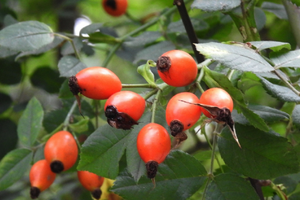 Did you know roses produce fruit? If you leave your roses on the bush, rather than pruning, a small red fruit will grow.
Did you know roses produce fruit? If you leave your roses on the bush, rather than pruning, a small red fruit will grow.
Tart and high in vitamin C, rosehips are delicious jammed or as a tea.
Rosehip tea is a refreshing tonic that can help you fight off winter colds and flu.
⇒ Three Powerful Natural Remedies You Need To Keep On Hand This Autumn
You can find rose hips on unattended rose bushes (or simply don’t prune yours). You just want to make sure you don’t forage from plants that may have been sprayed with harmful pesticides.
Grapes
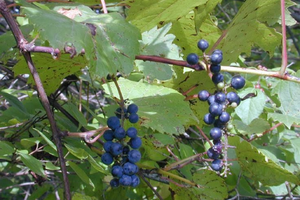 Another common fruit you can find growing is wild grape. Like their domesticated cousin, wild grapes grow in clusters on vines. They are deep purple, tending toward blackish. And they typically fruit from July until October, so keep an eye out for them on your autumn walks.
Another common fruit you can find growing is wild grape. Like their domesticated cousin, wild grapes grow in clusters on vines. They are deep purple, tending toward blackish. And they typically fruit from July until October, so keep an eye out for them on your autumn walks.
Persimmon
While you may think of Persimmons as a Southern fruit, they actually can be found growing as far north as New York and as far west as Texas.
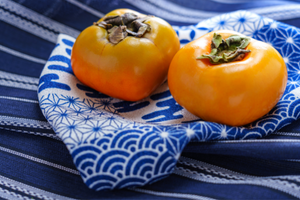
They ripen in mid to late fall, making them perfect for autumn foraging.
You can tell the fruit is ready to harvest because it is soft and detaches easily from the tree.
If your fruit is not quite ripe yet, it will continue to ripen once it’s been picked.
And you do want your persimmons ripe. They are decidedly tart before they ripen and deliciously sweet when ready.
You can eat them raw, use them for jams or desserts, or try your hand at Persimmon wine.
Elderberry
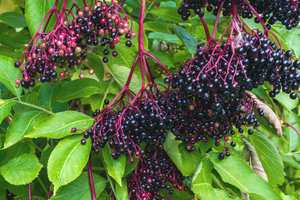 You can forage elderberry in the fall as a staple for your medicinal apothecary.
You can forage elderberry in the fall as a staple for your medicinal apothecary.
The deep purple berries have been used for centuries to treat colds and flu, as well as headaches, coughs, and issues.
The berries can be made into jam, syrup, or tea. Just make sure you cook them, as raw berries are poisonous. Consuming raw berries can cause gastrointestinal distress, vomiting, and diarrhea.
Wild Apples
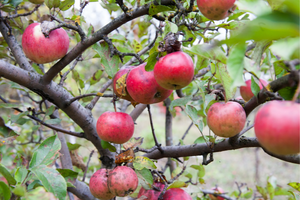 Apples abound in autumn. Many apple trees were planted in the past and give fruit long after the person who planted them is gone. Other apple trees grow wild from seeds casually strewn on a walk or from fallen fruit. Wild apples can be sweet or sour– you never know. All of these apples, including crab apples, can be foraged and eaten.
Apples abound in autumn. Many apple trees were planted in the past and give fruit long after the person who planted them is gone. Other apple trees grow wild from seeds casually strewn on a walk or from fallen fruit. Wild apples can be sweet or sour– you never know. All of these apples, including crab apples, can be foraged and eaten.
You can eat the sweet ones straight from the tree but save the tart and sour ones for baking. Pies are great, but applesauce and apple butter can be canned and eaten all winter long.
Making apple cider vinegar is another excellent use for your not so delicious foraged apples. Apple cider vinegar has many health benefits. It also makes a great base for immune boosting fire cider.
Black Walnut
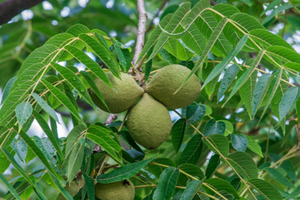 Black Walnuts ripen in September in October, so they are a perfect addition to your autumn foraging list.
Black Walnuts ripen in September in October, so they are a perfect addition to your autumn foraging list.
You can use the outer hulls to make an iodine-rich tincture.
This tincture is anti-viral, antifungal, anti-bacterial, and works as an antiparasitic.
Once you’ve removed the hulls for your tincture, you can try your hand at releasing the delicious nut hidden inside the hard shell. You’ll find it quite a challenge to reach the tasty nut. You can decide for yourself if all the hard work is worth it.
Cattail Roots
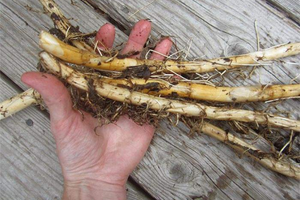 Cattails are easily recognizable by their fuzzy, sausage-like seed pods that give them their name.
Cattails are easily recognizable by their fuzzy, sausage-like seed pods that give them their name.
You can find them near ponds and swamps, as they like water. You should make sure you are always harvesting your cattails from an area that is free of any chemical runoff.
The plants are bio accumulators, which means that they absorb toxic chemicals. This is great if you are looking to clean your water but bad if you want to eat your cattails.
While you can forage cattails year round, we look for their roots (technically a rhizome) in the fall. You’ll find they are larger in the fall than at other times of the year.
Roots can be roasted and eaten or dried and pounded into flour. You can use cattail flour to make pancakes and other baked goods or as a thickener for soups, stews, and sauces.
Cranberries
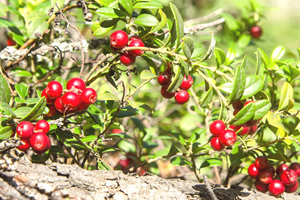 Cranberries are an iconic fall food that I personally feel are underappreciated.
Cranberries are an iconic fall food that I personally feel are underappreciated.
You can add these tart berries to muffins, juices, or, of course, made into cranberry sauce for your Thanksgiving dinner.
Not only do these berries taste great, but they are also medicinal as well.
Cranberries, especially cranberry juice, are often used to help with urinary tract infections. Studies have shown that the compounds in cranberries can help prevent UTIs.
They grow wild in the North Eastern US and Canada. Look for them near lakes, bogs, and swamps. They are ready to harvest in September and October. Keep your eye out for the deep red berries growing close to the ground.
Acorns
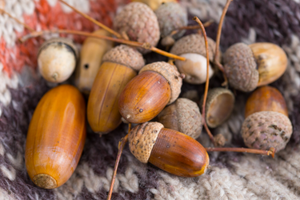 While we may think of acorns as squirrel food, we can eat them too. Unfortunately, we need to do a bit more work with the acorns before we can eat them. Without processing, acorns are high in tannins which can be toxic to humans.
While we may think of acorns as squirrel food, we can eat them too. Unfortunately, we need to do a bit more work with the acorns before we can eat them. Without processing, acorns are high in tannins which can be toxic to humans.
To make your acorn harvest safe for consumption, you will want to boil the acorn meat and then rinse them. You may have to do this several times before you leech out all the tannins. When the acorn meat no longer tastes bitter, you can grind it into a flour and use it for baking.
Sassafras
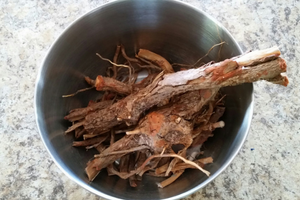 Sassafras was one of the first wild plants I learned to identify as a kid. I learned to identify the plant by its distinctive fragrant leaves.
Sassafras was one of the first wild plants I learned to identify as a kid. I learned to identify the plant by its distinctive fragrant leaves.
While the leaves disappear as fall progresses, you can still harvest the roots in autumn. These roots are what was traditionally used to brew root beer.
I say traditionally because, in the 1960s, the FDA prohibited the use of Sassafras. A scientific study found that large amounts of safrole, a compound found in the plant, potentially caused liver damage in rats.
Since then, people have called into question the study’s validity, and many foragers still use sassafras for tea, to treat ailments like diarrhea, colds, skin diseases. You, of course, will want to make your own judgment on the safety of this plant.
There are many plants that are out there that you can forage in the fall. This list just scratches the surface of the available bounty growing wild in our forests. While foraging can be very satisfying, always ensure you are extremely confident in your harvest before eating anything from the wild.
Always make sure you are foraging from areas that are free from dangerous pesticides and herbicides. Often municipal areas are sprayed to keep down “the weeds.”
You also need to make sure you are familiar with any potentially dangerous look-alikes. Foraging unfamiliar plants can be deadly.
As long as you use common sense and ensure you know the plants you are harvesting, you can easily supplement your diet with food found growing wild year-round.
This article was inspired by The Forager’s Guide to Wild Foods.
The Forager’s Guide to Wild Foods provides advice on how to harvest wild foods, how to recognize the best plants and herbs in your.jpeg) backyard, and how to employ tried-and-true foraging techniques to maximize the nutritional content of foraged foods. Dr. Nicole Apelian is an herbalist, biologist, survival skills educator, and mother who wrote The Forager’s Guide to Wild Foods. In a thorough foraging book, Dr. Apelian compiled her decades of research. These days, anyone can utilize the book to discover forging materials nearby. Get your copy HERE!
backyard, and how to employ tried-and-true foraging techniques to maximize the nutritional content of foraged foods. Dr. Nicole Apelian is an herbalist, biologist, survival skills educator, and mother who wrote The Forager’s Guide to Wild Foods. In a thorough foraging book, Dr. Apelian compiled her decades of research. These days, anyone can utilize the book to discover forging materials nearby. Get your copy HERE!
Anyone can join.
Anyone can contribute.
Anyone can become informed about their world.
"United We Stand" Click Here To Create Your Personal Citizen Journalist Account Today, Be Sure To Invite Your Friends.
Lion’s Mane Mushroom
Mushrooms are having a moment. One fabulous fungus in particular, lion’s mane, may help improve memory, depression and anxiety symptoms. They are also an excellent source of nutrients that show promise as a therapy for dementia, and other neurodegenerative diseases. If you’re living with anxiety or depression, you may be curious about all the therapy options out there — including the natural ones.Our Lion’s Mane WHOLE MIND Nootropic Blend has been formulated to utilize the potency of Lion’s mane but also include the benefits of four other Highly Beneficial Mushrooms. Synergistically, they work together to Build your health through improving cognitive function and immunity regardless of your age. Our Nootropic not only improves your Cognitive Function and Activates your Immune System, But it benefits growth of Essential Gut Flora, further enhancing your Vitality.
Our Formula includes:
Lion’s Mane Mushrooms which Increase Brain Power through nerve growth, lessen anxiety, reduce depression, and improve concentration. Its an excellent adaptogen, promotes sleep and improves immunity.
Shiitake Mushrooms which Fight cancer cells and infectious disease, boost the immune system, promotes brain function, and serves as a source of B vitamins.
Maitake Mushrooms which regulate blood sugar levels of diabetics, reduce hypertension and boosts the immune system.
Reishi Mushrooms which Fight inflammation, liver disease, fatigue, tumor growth and cancer. They Improve skin disorders and soothes digestive problems, stomach ulcers and leaky gut syndrome.
Chaga Mushrooms which have anti-aging effects, boost immune function, improve stamina and athletic performance, even act as a natural aphrodisiac, fighting diabetes and improving liver function.
Try Our Lion’s Mane WHOLE MIND Nootropic Blend 60 Capsules. Today Be 100% Satisfied Or Receive A Full Money Back Guarantee Order Yours Today By Following This Link.




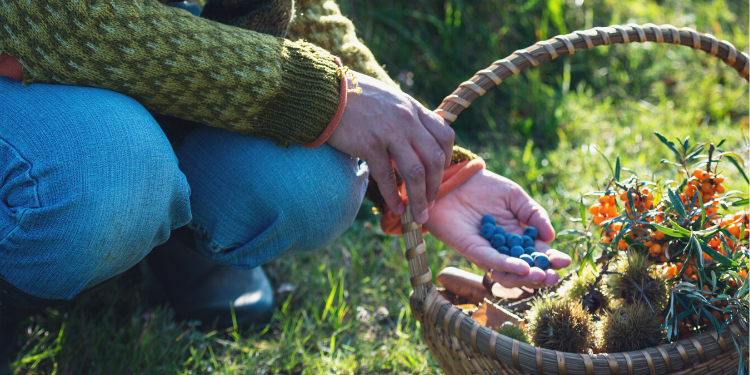 by
by 

